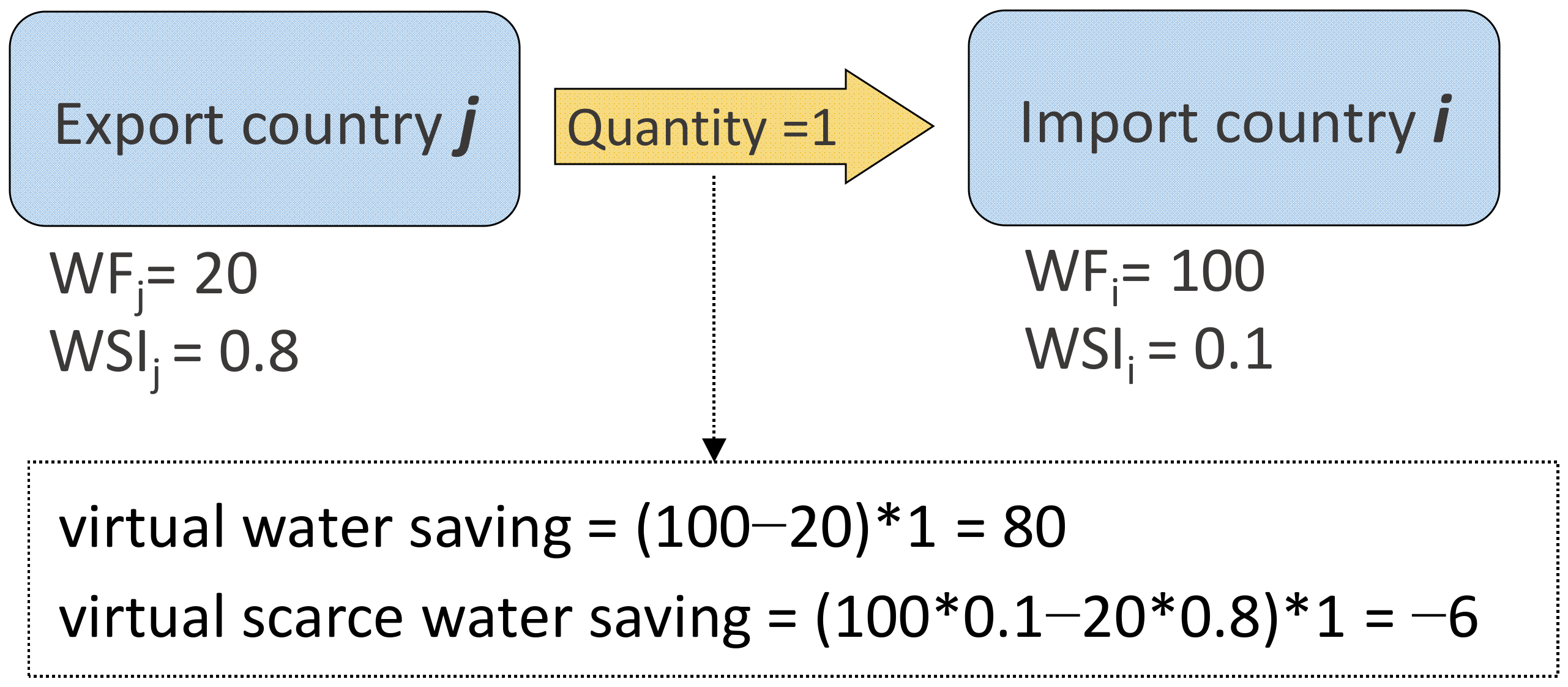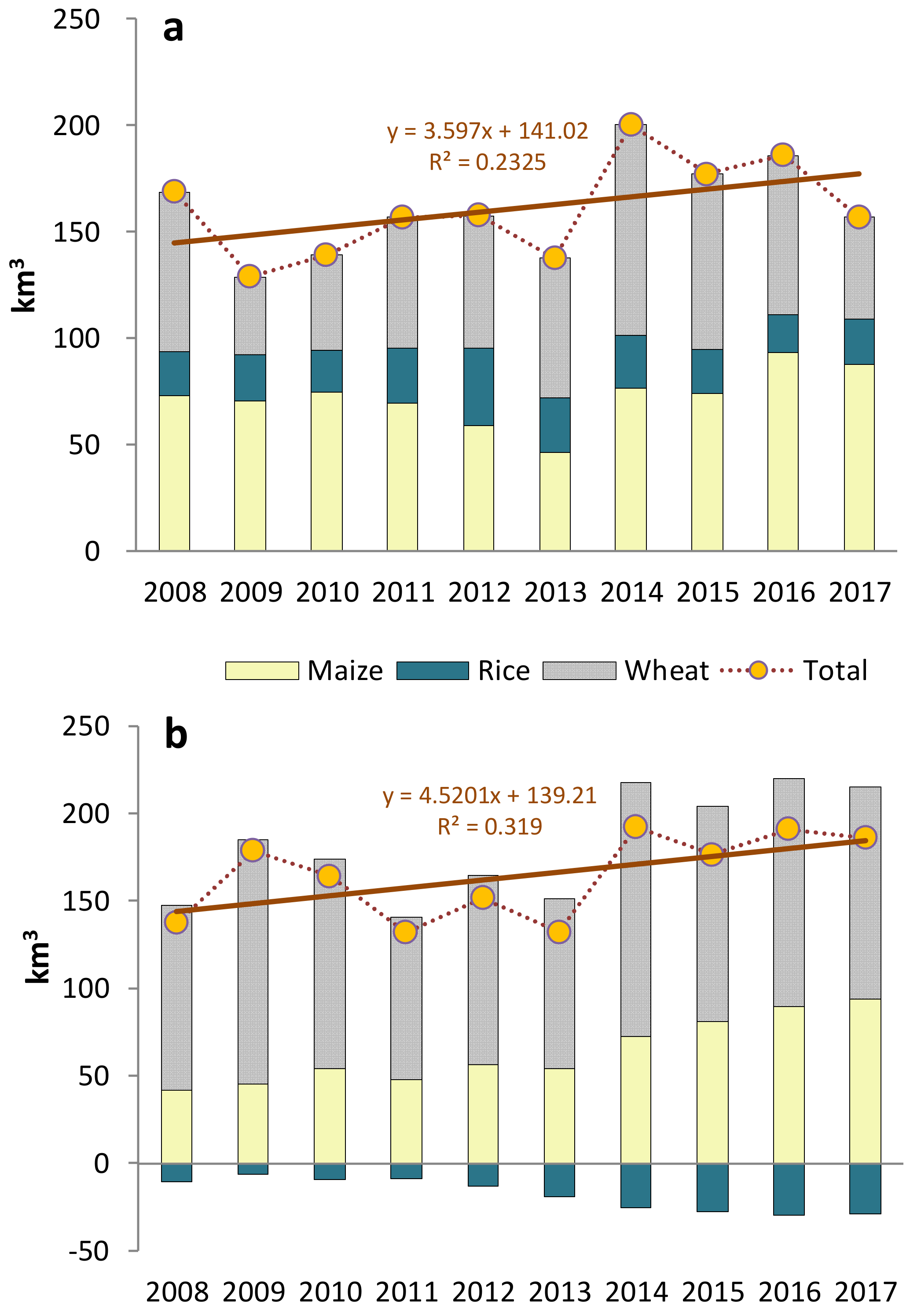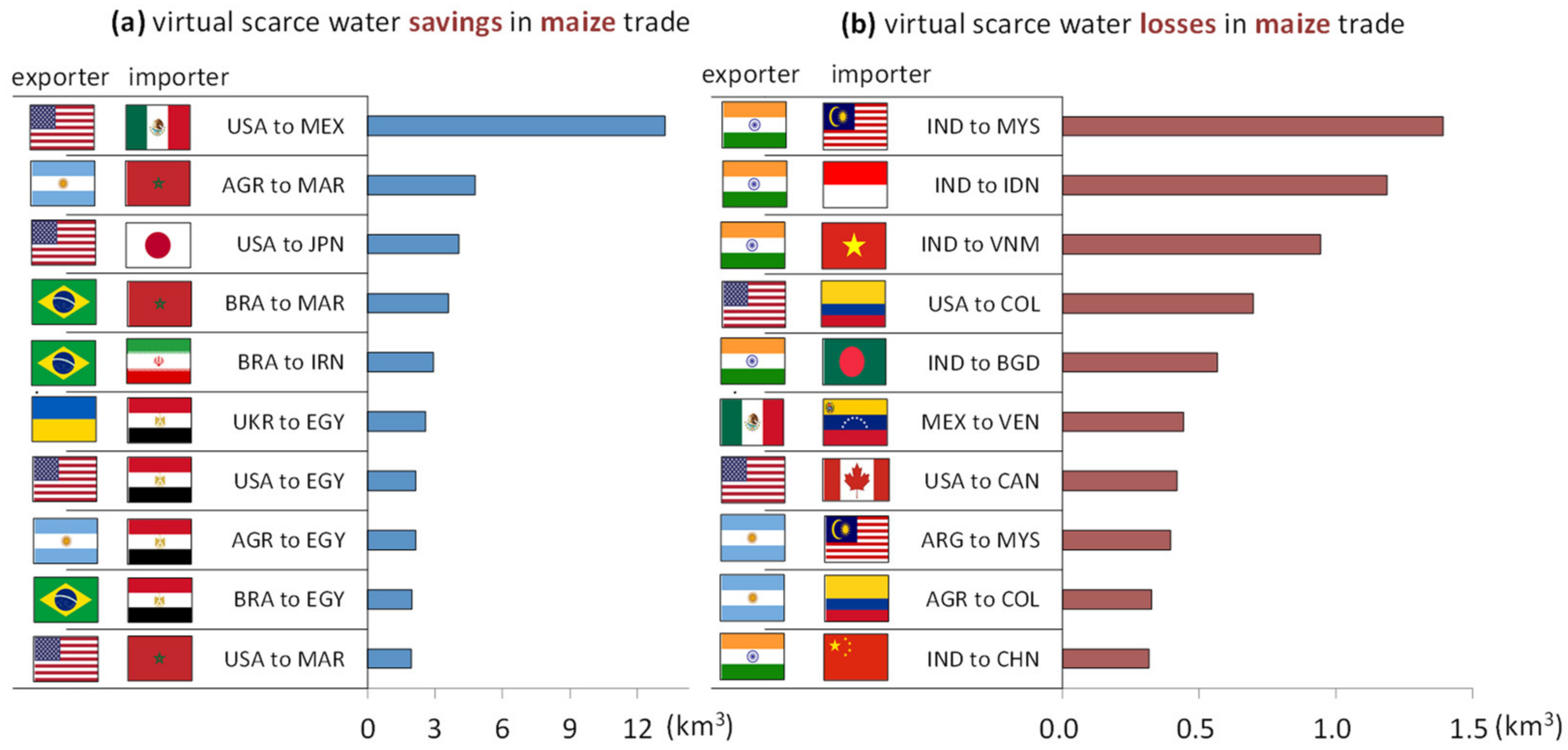Savings and Losses of Scarce Virtual Water in the International Trade of Wheat, Maize, and Rice
Abstract
:1. Introduction
2. Methodology
2.1. Global Virtual Water Savings in Wheat, Maize, and Rice Trade
2.2. Virtual Scarce Water Savings in Global Wheat, Maize, and Rice Trade
3. Results
3.1. Impacts on Global Water Resources from 2008 to 2017
3.2. VSW Savings and Losses in Top Trades of Maize
3.3. VSW Savings and Losses in Top Trades of Rice
3.4. VSW Savings and Losses in Top Trades of Wheat
3.5. Limitations and Uncertainties
4. Conclusions
Author Contributions
Funding
Institutional Review Board Statement
Informed Consent Statement
Data Availability Statement
Conflicts of Interest
References
- Mekonnen, M.M.; Hoekstra, A.Y. The green, blue and grey water footprint of crops and derived crop products. Hydrol. Earth Syst. Sci. 2011, 15, 1577–1600. [Google Scholar] [CrossRef] [Green Version]
- Allan, J. Fortunately there are substitutes for water otherwise our hydro-political futures would be impossible. In Priorities for Water Resources Allocation and Management; ODA: London, UK, 1993; pp. 13–26. [Google Scholar]
- D’Odorico, P.; Carr, J.; Laio, F.; Ridolfi, L. Spatial organization and drivers of the virtual water trade: A community-structure analysis. Environ. Res. Lett. 2012, 7, 034007. [Google Scholar] [CrossRef] [Green Version]
- Hoekstra, A.Y.; Chapagain, A.K.; Aldaya, M.M.; Mekonnen, M.M. The Water Footprint Assessment Manual: Setting the Global Standard; Earthscan: London, UK, 2011. [Google Scholar]
- Chai, L.; Han, Z.; Liang, Y.; Su, Y.; Huang, G. Understanding the blue water footprint of households in China from a perspective of consumption expenditure. J. Clean. Prod. 2020, 262, 121321. [Google Scholar] [CrossRef]
- Liao, X.; Chai, L.; Liang, Y. Income impacts on household consumption’s grey water footprint in China. Sci. Total Environ. 2021, 755, 142584. [Google Scholar] [CrossRef]
- Chai, L.; Liao, X.; Yang, L.; Yan, X. Assessing life cycle water use and pollution of coal-fired power generation in China using input-output analysis. Appl. Energy 2018, 231, 951–958. [Google Scholar] [CrossRef]
- Liu, W.; Yang, H.; Liu, Y.; Kummu, M.; Hoekstra, A.; Liu, J.; Schulin, R. Water resources conservation and nitrogen pollution reduction under global food trade and agricultural intensification. Sci. Total Environ. 2018, 633, 1591–1601. [Google Scholar] [CrossRef] [Green Version]
- Han, M.; Chen, G.; Li, Y. Global water transfers embodied in international trade: Tracking imbalanced and inefficient flows. J. Clean. Prod. 2018, 184, 50–64. [Google Scholar] [CrossRef]
- Hoekstra, A.Y.; Mekonnen, M.M. The water footprint of humanity. Proc. Natl. Acad. Sci. USA 2012, 109, 3232–3237. [Google Scholar] [CrossRef] [Green Version]
- Antonelli, M.; Tamea, S.; Yang, H. Intra-EU agricultural trade, virtual water flows and policy implications. Sci. Total Environ. 2017, 587–588, 439–448. [Google Scholar] [CrossRef]
- Faramarzi, M.; Yang, H.; Mousavi, J.; Schulin, R.; Binder, C.R.; Abbaspour, K.C. Analysis of intra-country virtual water trade strategy to alleviate water scarcity in Iran. Hydrol. Earth Syst. Sci. 2010, 14, 1417–1433. [Google Scholar] [CrossRef] [Green Version]
- Liu, A.; Han, A.; Chai, L. Life Cycle Blue and Grey Water in the Supply Chain of China’s Apparel Manufacturing. Processes 2021, 9, 1212. [Google Scholar] [CrossRef]
- Salmoral, G.; Yan, X. Food-energy-water nexus: A life cycle analysis on virtual water and embodied energy in food consumption in the Tamar catchment, UK. Resour. Conserv. Recycl. 2018, 133, 320–330. [Google Scholar] [CrossRef]
- Dalin, C.; Konar, M.; Hanasaki, N.; Rinaldo, A.; Rodriguez-Iturbe, I. Evolution of the global virtual water trade network. Proc. Natl. Acad. Sci. USA 2012, 109, 5989–5994. [Google Scholar] [CrossRef] [Green Version]
- Konar, M.; Reimer, J.J.; Hussein, Z.; Hanasaki, N. The water footprint of staple crop trade under climate and policy scenarios. Environ. Res. Lett. 2016, 11, 35006. [Google Scholar] [CrossRef] [Green Version]
- Oki, T.; Kanae, S. Virtual water trade and world water resources. Water Sci. Technol. 2004, 49, 203–209. [Google Scholar] [CrossRef]
- Yang, H.; Wang, L.; Abbaspour, K.C.; Zehnder, A.J.B. Virtual water trade: An assessment of water use efficiency in the international food trade. Hydrol. Earth Syst. Sci. 2006, 10, 443–454. [Google Scholar] [CrossRef] [Green Version]
- Gawel, E.; Bernsen, K. What Is Wrong with Virtual Water Trading? On the Limitations of the Virtual Water Concept. Environ. Plan. C: Gov. Policy 2013, 31, 168–181. [Google Scholar] [CrossRef]
- Tuninetti, M.; Tamea, S.; Dalin, C. Water Debt Indicator Reveals Where Agricultural Water Use Exceeds Sustainable Levels. Water Resour. Res. 2019, 55, 2464–2477. [Google Scholar] [CrossRef] [Green Version]
- Rosa, L.; Chiarelli, D.D.; Tu, C.; Rulli, M.C.; D’Odorico, P. Global unsustainable virtual water flows in agricultural trade. Environ. Res. Lett. 2019, 14, 114001. [Google Scholar] [CrossRef]
- Lenzen, M.; Moran, D.; Bhaduri, A.; Kanemoto, K.; Bekchanov, M.; Geschke, A.; Foran, B. International trade of scarce water. Ecol. Econ. 2013, 94, 78–85. [Google Scholar] [CrossRef]
- Vallino, E.; Ridolfi, L.; Laio, F. Trade of economically and physically scarce virtual water in the global food network. Sci. Rep. 2021, 11, 22806. [Google Scholar] [CrossRef] [PubMed]
- Pfister, S.; Koehler, A.; Hellweg, S. Assessing the Environmental Impacts of Freshwater Consumption in LCA. Environ. Sci. Technol. 2009, 43, 4098–4104. [Google Scholar] [CrossRef] [PubMed] [Green Version]
- ISO. ISO 14046:2014 Environmental Management—Water Footprint—Principles, Requirements and Guidelines. 2014. Available online: https://www.iso.org/standard/43263.html (accessed on 25 March 2022).
- Islam, S.; Oki, T.; Kanae, S.; Hanasaki, N.; Agata, Y.; Yoshimura, K. A grid-based assessment of global water scarcity including virtual water trading. Water Resour. Manag. 2007, 21, 19–33. [Google Scholar] [CrossRef]
- Oki, T.; Yano, S.; Hanasaki, N. Economic aspects of virtual water trade. Environ. Res. Lett. 2017, 12, 044002. [Google Scholar] [CrossRef]
- Mekonnen, M.M.; Hoekstra, A.Y. National Water Footprint Accounts: The Green, Blue and Grey Water Footprint of Production and Consumption (Value of Water Research Report Series No. 50); UNESCO-IHE: Delft, The Netherlands, 2011. [Google Scholar]
- Zhao, X.; Li, Y.P.; Yang, H.; Liu, W.F.; Tillotson, M.R.; Guan, D.; Yi, Y.; Wang, H. Measuring scarce water saving from interregional virtual water flows in China. Environ. Res. Lett. 2018, 13, 054012. [Google Scholar] [CrossRef]
- Vanham, D.; Gawlik, B.; Bidoglio, G. Food consumption and related water resources in Nordic cities. Ecol. Indic. 2017, 74, 119–129. [Google Scholar] [CrossRef]
- Finogenova, N.; Dolganova, I.; Berger, M.; Núñez, M.; Blizniukova, D.; Müller-Frank, A.; Finkbeiner, M. Water footprint of German agricultural imports: Local impacts due to global tradeflows in a fifteen-year perspective. Sci. Total Environ. 2019, 662, 521–529. [Google Scholar] [CrossRef]
- FAOSTAT a. Detailed Trade Matrix. Available online: http://www.fao.org/faostat/en/#data/TM (accessed on 2 June 2020).
- Liu, W.; Antonelli, M.; Kummu, M.; Zhao, X.; Wu, P.; Liu, J.; Zhuo, L.; Yang, H. Savings and losses of global water resources in food-related virtual water trade. WIREs Water 2019, 6, e1320. [Google Scholar] [CrossRef] [Green Version]
- USDA. Grain: World Markets and Trade. Available online: https://www.magyp.gob.ar/new/0-0/programas/dma/usda/grains/2010/2010-07-15.pdf (accessed on 30 August 2009).
- FAOSTAT b. Crops. Available online: http://www.fao.org/faostat/en/#data/QC (accessed on 2 June 2020).
- Taylor Richard, D.; Koo Won, W. 2015 Outlook of the U.S. and World Wheat Industries, 2015–2024, Agribusiness & Applied Economics Report 201310, North Dakota State University, Department of Agribusiness and Applied Economics. 2015. Available online: https://ideas.repec.org/p/ags/nddaae/201310.html (accessed on 12 July 2010).
- Meade, B.; Puricelli, E.; McBride, W.; Valdes, C.; Hoffman, L.; Foreman, L.; Dohlman, E. Corn and Soybean Production Costs and Export Competitiveness in Argentina, Brazil, and the United States. 2016. Available online: https://www.ers.usda.gov/webdocs/publications/44087/59672_eib-154_errata.pdf?v=0 (accessed on 19 March 2022).
- USDA. Crop Production 2019 Summary. Available online: https://www.nass.usda.gov/Publications/Todays_Reports/reports/cropan20.pdf (accessed on 20 January 2020).
- Maize in India. 2014. Available online: http://ficci.in/spdocument/20386/India-Maize-2014_v2.pdf (accessed on 23 February 2022).
- Ewaid, S.H.; Abed, S.A.; Al-Ansari, N. Assessment of Main Cereal Crop Trade Impacts on Water and Land Security in Iraq. Agronomy 2020, 10, 98. [Google Scholar] [CrossRef] [Green Version]
- Nasrin, S.; Lodin, J.B.; Jirström, M.; Holmquist, B.; Djurfeldt, A.A.; Djurfeldt, G. Drivers of rice production: Evidence from five Sub-Saharan African countries. Agric. Food Secur. 2015, 4, 12. [Google Scholar] [CrossRef] [Green Version]
- Kahlown, M.; Raoof, A.; Zubair, M.; Kemper, D. Water Use Efficiency and Economic Feasibility of Growing Rice and Wheat with Sprinkler Irrigation in the Indus Basin of Pakistan. Available online: https://www.sciencedirect.com/science/article/abs/pii/S0378377406002198 (accessed on 19 March 2022).
- Apipattanavis, S.; Ketpratoom, S.; Kladkempetch, P. Water Management in Thailand. Irrig. Drain. 2018, 67, 113–117. [Google Scholar] [CrossRef]
- Ngammuangtueng, P.; Jakrawatana, N.; Nilsalab, P.; Gheewala, S. Water, Energy and Food Nexus in Rice Production in Thailand. Sustainability 2019, 11, 5852. [Google Scholar] [CrossRef] [Green Version]
- Van Vliet, M.T.; Flörke, M.; Wada, Y. Quality matters for water scarcity. Nat. Geosci. 2017, 10, 800–802. [Google Scholar] [CrossRef]
- Van Vliet, M.T.H.; Jones, E.R.; Flörke, M.; Franssen, W.H.P.; Hanasaki, N.; Wada, Y.; Yearsley, J.R. Global water scarcity including surface water quality and expansions of clean water technologies. Environ. Res. Lett. 2021, 16, 024020. [Google Scholar] [CrossRef]
- Vallino, E.; Ridolfi, L.; Laio, F. Measuring economic water scarcity in agriculture: A cross-country empirical investigation. Environ. Sci. Policy 2020, 114, 73–85. [Google Scholar] [CrossRef]
- Verma, S.; Kampman, D.A.; van der Zaag, P.; Hoekstra, A. Going against the flow: A critical analysis of inter-state virtual water trade in the context of India’s National River Linking Program. Phys. Chem. Earth Parts A/B/C 2009, 34, 261–269. [Google Scholar] [CrossRef]





Publisher’s Note: MDPI stays neutral with regard to jurisdictional claims in published maps and institutional affiliations. |
© 2022 by the authors. Licensee MDPI, Basel, Switzerland. This article is an open access article distributed under the terms and conditions of the Creative Commons Attribution (CC BY) license (https://creativecommons.org/licenses/by/4.0/).
Share and Cite
Wu, H.; Jin, R.; Liu, A.; Jiang, S.; Chai, L. Savings and Losses of Scarce Virtual Water in the International Trade of Wheat, Maize, and Rice. Int. J. Environ. Res. Public Health 2022, 19, 4119. https://doi.org/10.3390/ijerph19074119
Wu H, Jin R, Liu A, Jiang S, Chai L. Savings and Losses of Scarce Virtual Water in the International Trade of Wheat, Maize, and Rice. International Journal of Environmental Research and Public Health. 2022; 19(7):4119. https://doi.org/10.3390/ijerph19074119
Chicago/Turabian StyleWu, Hanfei, Ruochen Jin, Ao Liu, Shiyun Jiang, and Li Chai. 2022. "Savings and Losses of Scarce Virtual Water in the International Trade of Wheat, Maize, and Rice" International Journal of Environmental Research and Public Health 19, no. 7: 4119. https://doi.org/10.3390/ijerph19074119
APA StyleWu, H., Jin, R., Liu, A., Jiang, S., & Chai, L. (2022). Savings and Losses of Scarce Virtual Water in the International Trade of Wheat, Maize, and Rice. International Journal of Environmental Research and Public Health, 19(7), 4119. https://doi.org/10.3390/ijerph19074119






